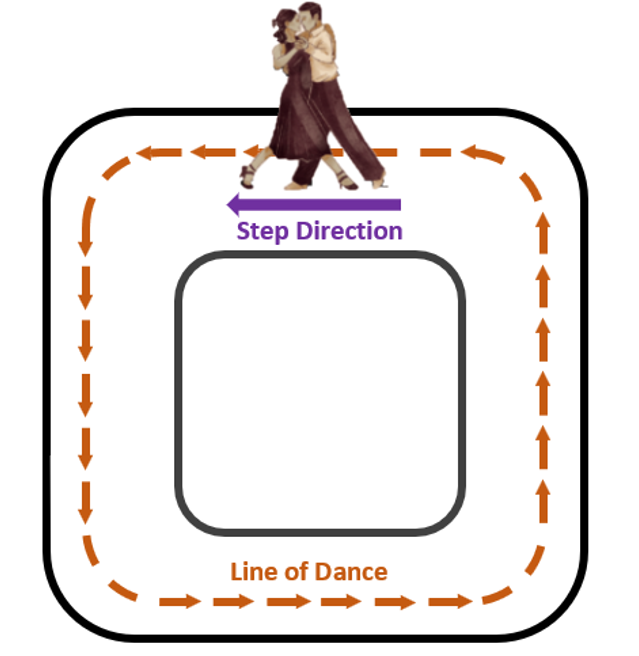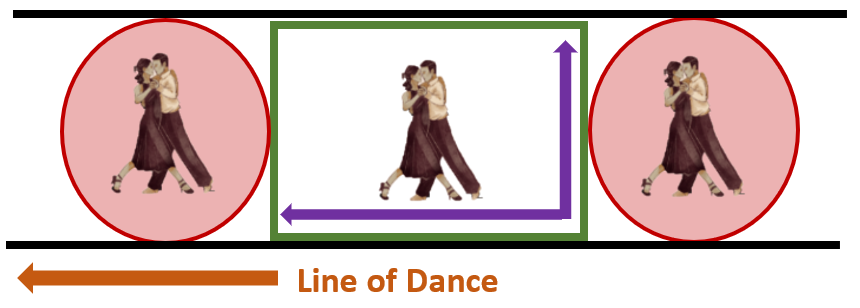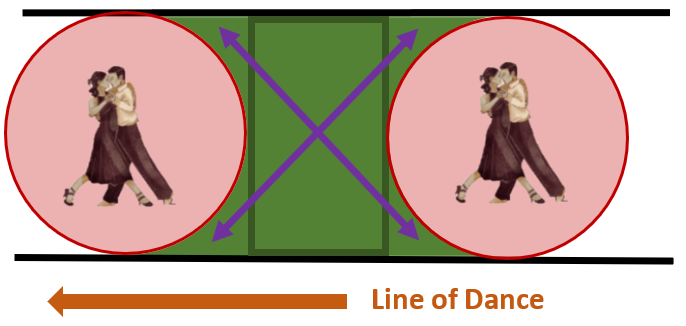Travel to anywhere in the world where tango is danced, and you will hear the same conversation.
“How was the milonga last night?”
“The venue was great and the music better, but the navigation left much to be desired.”
While complaining about the navigation of others is a time-honored tradition, what can we do to improve our own navigation? Experienced dancers come up with their set of tricks to fit the moves they want into the space they have, but these are seldom taught. Wouldn’t it be nice to have a simple strategy that gives you and the couples around you more space to dance, that gives you freedom to move even on a crowded dance floor, and lets the other dancers on the floor feel safe and relaxed? If you answered yes, then read on.
Here is the trick for better navigation:
The line of dance is not the line you should dance.
Let me explain. The line of dance goes around the room counterclockwise and is the general direction of couples in the ronda. Your step direction is the direction on the floor that you are stepping. With lots of space, the line of dance and the step direction are generally the same. But when the dance floor becomes crowded, we need to change our steps to fit into the new space.

The two figures below show what changes as the dance floor gets more crowded. Each lane of the ronda has a width that we can dance in. We want to give other couples enough space to dance, so we can think of an invisible bubble around the couple in front and behind us that we want to avoid stepping inside. Thus, there is a box that we fit our movements inside. When the floor is sparse, our box is long in the direction of the line of dance. But when the floor becomes more crowded, our box becomes compressed and it is wider in the direction perpendicular to the line of dance. Thus, on a crowded dance floor, we have more space when our step direction is perpendicular to the line of dance.


The small change of dancing more perpendicular to the line of dance—generally with the open side of the embrace facing the line of dance—can provide a lot more space. This is sometimes referred to as dancing in the slot, and is a tried-and-true strategy for navigation used by experienced couples. But what if we need or want more space?
Our imaginary box has diagonals that we can step on. Simple geometry says the diagonals of a box are longer than the edges. Thus, dancing diagonal to the line of dance gives us more space to step. By stepping in our slot, and in the diagonals of our box, we can have enough room to do most of the movements we want. If we need to, though, the diagonals can give us even more room. To realize this, we need to think outside the box—or in this case step outside the box.
The other couples are also dancing in boxes of their own. If the other couple is in the center of their box, then the corners are farther away from them than the middle. We can actually borrow some of the corner of their box while still being safe and giving them the space they need to feel comfortable. The trick here is that you need to be conscious and courteous of the other dancers.

The middle of our box is ours, but the corners are shared space. We can use a corner when the other couple isn’t, and they get to use our corner when we aren’t, but we can’t both share the same corner at the same time. To find space on a crowded dance floor, use the corners of your box, but make sure it is not a corner the other couple is using.
This is where the fun of navigation really begins. Dancing in relation to the couple in front and behind us allows us to all create space for each other. The other couples are not stationary but are moving in their own box. This movement creates and takes away space for us, and our movement can create or take away space for them. Dancing in relation to the couple in front and behind us allows us to all create space for each other. By paying attention to the movement of the couples in front and behind us, we can know when a corner is free to step in and when we should stay in the middle of our box. We can all feel safe and relaxed while also having the space to feel creative. Just as important, sharing the corners and navigating the space with the other couples adds a whole new layer of enjoyment to the dance. The couples around us are no longer simply obstacles to avoid, but become partners in crime, providing inspiration and direction for our own dance.
3 Comments
David Phillips · February 5, 2023 at 9:13 pm
Your analyses (here and in your other articles), expressed in simple, clear, observable terms, give practical, easily used ways to improve our dancing. Thank you!
Steve P · February 6, 2023 at 2:47 pm
Great timing with the publishing of this article for me! Great insights, thank you!
sericson0 · February 10, 2023 at 5:36 pm
So glad to hear it was helpful Steve!
Comments are closed.